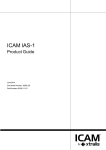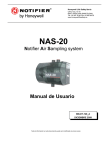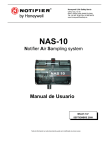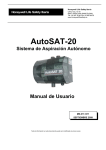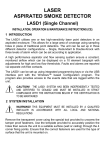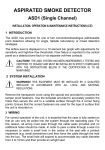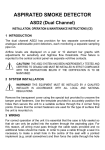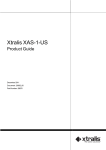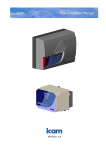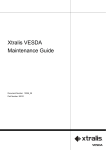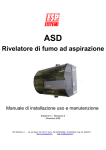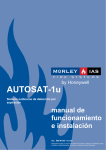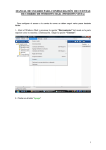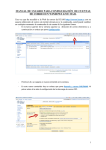Download Xtralis ICAM ILS-1
Transcript
Xtralis ICAM ILS-1
Product Guide
January 2009
Document Number: 16277_00
Part Number: 09-0113-10
Xtralis ICAM
Xtralis ICAM ILS-1 Product Guide
Intellectual Property and Copyright
This document includes registered and unregistered trademarks. All trademarks displayed are the trademarks of their
respective owners. Your use of this document does not constitute or create a licence or any other right to use the name and/or
trademark and/or label.
This document is subject to copyright owned by Xtralis AG (“Xtralis”). You agree not to copy, communicate to the public, adapt,
distribute, transfer, sell, modify or publish any contents of this document without the express prior written consent of Xtralis.
Disclaimer
The contents of this document is provided on an “as is” basis. No representation or warranty (either express or implied) is
made as to the completeness, accuracy or reliability of the contents of this document. The manufacturer reserves the right to
change designs or specifications without obligation and without further notice. Except as otherwise provided, all warranties,
express or implied, including without limitation any implied warranties of merchantability and fitness for a particular purpose are
expressly excluded.
General Warning
This product must only be installed, configured and used strictly in accordance with the General Terms and Conditions, User
Manual and product documents available from Xtralis. All proper health and safety precautions must be taken during the
installation, commissioning and maintenance of the product. The system should not be connected to a power source until all
the components have been installed. Proper safety precautions must be taken during tests and maintenance of the products
when these are still connected to the power source. Failure to do so or tampering with the electronics inside the products can
result in an electric shock causing injury or death and may cause equipment damage. Xtralis is not responsible and cannot be
held accountable for any liability that may arise due to improper use of the equipment and/or failure to take proper precautions.
Only persons trained through an Xtralis accredited training course can install, test and maintain the system.
Liability
You agree to install, configure and use the products strictly in accordance with the User Manual and product documents
available from Xtralis.
Xtralis is not liable to you or any other person for incidental, indirect, or consequential loss, expense or damages of any kind
including without limitation, loss of business, loss of profits or loss of data arising out of your use of the products. Without
limiting this general disclaimer the following specific warnings and disclaimers also apply:
Fitness for Purpose
You agree that you have been provided with a reasonable opportunity to appraise the products and have made your own
independent assessment of the fitness or suitability of the products for your purpose. You acknowledge that you have not relied
on any oral or written information, representation or advice given by or on behalf of Xtralis or its representatives.
Total Liability
To the fullest extent permitted by law that any limitation or exclusion cannot apply, the total liability of Xtralis in relation to the
products is limited to:
i.
ii.
in the case of services, the cost of having the services supplied again; or
in the case of goods, the lowest cost of replacing the goods, acquiring equivalent goods or having the goods repaired.
Indemnification
You agree to fully indemnify and hold Xtralis harmless for any claim, cost, demand or damage (including legal costs on a full
indemnity basis) incurred or which may be incurred arising from your use of the products.
Miscellaneous
If any provision outlined above is found to be invalid or unenforceable by a court of law, such invalidity or unenforceability will
not affect the remainder which will continue in full force and effect. All rights not expressly granted are reserved.
www.xtralis.com
i
Xtralis ICAM ILS-1 Product Guide
Xtralis ICAM
Document Conventions
The following typographic conventions are used in this document:
Convention
Description
Bold
Used to denote: emphasis Used for names of menus, menu options,
toolbar buttons
Italics
Used to denote: references to other parts of this document or other
documents. Used for the result of an action.
The following icons are used in this document:
Convention
Description
Caution: This icon is used to indicate that there is a danger to equipment.
The danger could be loss of data, physical damage, or permanent
corruption of configuration details.
Warning: This icon is used to indicate that there is a danger of electric
shock. This may lead to death or permanent injury.
Warning: This icon is used to indicate that there is a danger of inhaling
dangerous substances. This may lead to death or permanent injury.
Contact Us
The Americas
+1 781 740 2223
Asia
+86 21 5240 0077
Australia and New Zealand
+61 3 9936 7000
Europe, Middle East & Africa
+41 1903 89 22 22
www.xtralis.com
ii
www.xtralis.com
Xtralis ICAM
Xtralis ICAM ILS-1 Product Guide
Table of Contents
1
Introduction................................................................................................................................1
2
Mounting the Detector ..............................................................................................................2
3
Wiring Connections...................................................................................................................3
3.1
Field Connections ..............................................................................................................3
4
Pipe Installation .........................................................................................................................5
4.1
Pipe Specification ..............................................................................................................5
4.2
Fixings ...............................................................................................................................5
4.3
Bends.................................................................................................................................5
4.4
End Cap.............................................................................................................................6
4.5
Holes..................................................................................................................................6
4.6
Exhaust..............................................................................................................................6
4.7
Filters .................................................................................................................................6
4.8
Standard Pipe Configurations............................................................................................6
5
Detectors ....................................................................................................................................8
6
Setup...........................................................................................................................................9
6.1
Display Functions ..............................................................................................................9
6.2
User Functions.................................................................................................................10
6.3
Setup Notes .....................................................................................................................12
7
Testing......................................................................................................................................14
7.1
Detectors .........................................................................................................................14
7.2
System.............................................................................................................................14
8
Maintenance.............................................................................................................................15
9
EN54-20 Sensitivity Classes...................................................................................................16
10
Problem Solving...................................................................................................................17
11
Specifications.......................................................................................................................18
www.xtralis.com
iii
Xtralis ICAM
Xtralis ICAM ILS-1 Product Guide
1 Introduction
The Xtralis ICAM ILS-1 system is an aspirating smoke system that utilizes an air-sampling pipe network
to draw air towards one or two high-sensitivity laser point detectors in an aspirated enclosure. The use
of the pipe network allows a larger area of coverage in comparison to traditional point detectors. Three
different operating modes (Single, Redundant and Double-Knock) and three programmable alarm levels
are provided enabling the system to be configured according to application.
A high performance aspirator and flow sensing system ensure a constant, monitored airflow. The
amount of airflow can be displayed on a ten-element bargraph with adjustments for high and low flow
thresholds. All detector configuration can be achieved with the integrated programming keys located on
the side of the device.
The ILS-1 is a standalone system where faults and alarms are reported via separate volt-free contacts.
These contacts may be connected to a monitoring fire alarm control panel.
Important Note: Aspirating Smoke Detectors supplied and installed within the EU from June 2009
must conform to the EU Construction Products Directive (89/106/EEC) and the related European
Standard EN54-20.
This unit has been tested and certified to ensure general conformance to the above directive and
standard but strict adherence to this Product Guide is required to ensure that the installation
meets these requirements in all respects.
www.xtralis.com
1
Xtralis ICAM ILS-1 Product Guide
Xtralis ICAM
2 Mounting the Detector
Note: This equipment must be installed by a qualified installer in accordance with all local and national
regulations.
Remove the transparent cover using the special tool provided to unscrew the tamper proof fasteners.
Use the template provided to accurately position the holes then secure the unit to a suitable surface
(wall or ceiling) through the four corner fixing points. Ensure that the correct fasteners are used for the
type of surface that the unit is mounted on.
2
www.xtralis.com
Xtralis ICAM
Xtralis ICAM ILS-1 Product Guide
3 Wiring Connections
For correct operation of the unit it is essential that the case is fully sealed so that air can only be drawn
into the system through the aspirating pipe. For this reason, all wiring must pass through the cable seals
provided and no additional holes should be made. In order to pass a cable through a seal, make a small
hole in the center of the seal with a pointed implement (e.g. small screwdriver) and then force the cable
through the hole into the unit. The small hole will expand to accommodate cable diameters from 4 to 10
mm and then provide an airtight seal.
In order to gain access to the main circuit board for connection of the wiring, remove the
display/detector mounting board held in place by the clear top cover. Care should be taken when
removing the board to ensure that the ribbon cable on the underside is not strained. The ribbon cable
may be removed from the connector on the underside of the board to allow the board to be fully
removed.
To prevent risk of electric shock, or possible injury from the rotation of the high
performance fan, the system should be isolated form the supply when the top cover is
removed.
All connections to the main circuit board are to pluggable terminals that can accommodate wire sizes up
to 2.5 mm2.
3.1 Field Connections
Figure 3-1: Field connections for an ILS-1 system
3.1.1 Battery / Input Power Connection
Figure 3-2: Ferrite core and battery supply wiring
www.xtralis.com
3
Xtralis ICAM ILS-1 Product Guide
Xtralis ICAM
The ILS-1 unit is designed to run from a 24 VDC power supply. The power supply should be connected
to the two-way BATTERY terminal on the main circuit board ensuring that the wires are correctly
orientated. The minimum recommended wire size is 16 x 0.25 mm (18 AWG), or larger if the supply is
further than 5 m from the system.
A ferrite core is provided for EMC compliance. This should be fitted to the power supply wiring inside the
unit as shown above.
The power requirements are dependant on the fan speed selected, please refer to Table 11-2: Typical
Current Consumption vs Fan Speed for details.
3.1.2 ACTION 2 Relay Contacts
The dry relay contacts ACTION will change state when the pre-alarm level for the channel has been
exceeded. The terminals provide for Normally Open (NO) or Normally Closed (NC) operation.
3.1.3 FIRE 2 Relay Contacts
The dry relay contacts FIRE will change state when the alarm level for the channel has been exceeded.
The terminals provide for Normally Open (NO) or Normally Closed (NC) operation
3.1.4 FAULT 2 Relay Contacts
In the event of a fault condition, the Fault relay will change state. The terminals provide for Normally
Open (NO) or Normally Closed (NC) operation.
Note: NO/NC refers to the un-powered state of the relays. Under normal, non-fault conditions, NO is
closed and NC is open.
3.1.5 External Reset
The application of a nominal 24 VDC signal to these pins forces the unit into Reset clearing all faults
and alarms.
3.1.6 USB Connector
A Type B USB connector is provided on the bottom of the unit to allow connection to a PC using a
standard USB cable (not supplied). This communication port allows for configuration or downloading of
logged data using Xtralis VSC, a comprehensive configuration software tool available as a download
from www.xtralis.com. The connector is protected with a screw-fit cover and care should be taken to
ensure that the cover is securely fastened when the connector is not in use to prevent the ingress of dirt
or moisture.
4
www.xtralis.com
Xtralis ICAM
Xtralis ICAM ILS-1 Product Guide
4 Pipe Installation
A simple guide to pipe installation follows with examples of standard configurations.
Note: Xtralis ASPIRE2 may be downloaded from www.xtralis.com and should be used to calculate
transport times, dilution effects etc. for all installations beyond the scope of this guide.
Use 25 mm (or ¾”) Red ABS pipe with sampling point holes drilled along its length. The pipe run is
terminated with an end cap that has a hole drilled in its center.
The position of each individual sampling point should adhere to guidelines for positioning point
detectors. It is important to note that the smoke concentration from an individual sample point will be
diluted by the clean air from the other sample points and the end cap hole.
4.1 Pipe Specification
For EN54-20 compliance, the pipe should be Red ABS to EN 50086-1 (Crush 1, Impact 1, Temp 31)
with a nominal outer diameter of 25 mm (or ¾”). The sampling pipe is normally supplied in 3 m lengths
and is cut as required and joined by solvent welded sockets (permanent), or socket unions (removable).
Note: The ILS-1 inlet port is tapered to allow a push fit of the sampling pipe. The pipe should be cut
squarely to ensure a good, airtight seal. Solvent adhesive should not be used for this joint.
4.2 Fixings
The normal fixing methods are pipe clips, saddle clamps or even tie wraps. Fixing centers are typically
1.5 m apart.
4.3 Bends
Figure 4-1: 45° bend and 90° swept bend
Bends are either 45° or 90°. For 90° bends it is very important that swept bends are used and not sharp
elbows, as sharp elbows introduce unacceptable pressure losses and significantly increase the
response times from holes beyond the bend.
www.xtralis.com
5
Xtralis ICAM ILS-1 Product Guide
Xtralis ICAM
4.4 End Cap
Figure 4-2: End cap with hole drilled in center
The end of the pipe is terminated with a cap, usually with a hole drilled in its center. If the end cap is not
used, then almost no air will be drawn through the side holes. The end cap can be considered a
sampling point if required.
4.5 Holes
The sampling pipe is perforated with sampling holes and can be drilled before or after installation. Care
should be taken to avoid swarf entering the pipe. Always blow compressed air through the pipe after
drilling to clear any debris before final connection to the equipment. In standard installations, with pipe
hanging from ceiling, the holes should be placed underneath, so the smoke can easily rise up into the
holes.
4.6 Exhaust
In most installations the exhaust should be left open but it may sometimes be necessary to connect pipe
to the exhaust port to divert the exhaust away from the location of the unit e.g. to reduce noise, reduce
risk of interference/deliberate obstruction, improved environmental protection etc.
Pipe of the same specification as the sampling pipe runs should be used and its length limited to a
maximum of 10 m to avoid significant reduction in the air flow. Care should be taken to position the new
exhaust outlet where it cannot be accidentally or deliberately blocked.
4.7 Filters
Figure 4-3: Filter at the inlet of an ILS system
The sampled air is passed through a filter (order code: FL53) before entering the detector chamber.
4.8 Standard Pipe Configurations
All configurations with maximum pipe length or number of sample holes should have the Alarm (Fire)
threshold set to Level 1 and Fan Speed set to 9. The use of additional bends as described in Section
4.3 will have minimal effect on performance (e.g. response time).
Note: Stated limits are based on EN54-20 certification testing. Reductions in pipe length may allow the
fan speed to be reduced and/or number of holes or alarm threshold level increased. Results of
such changes, or non-standard or unbalanced configurations, should be verified by using Xtralis
ASPIRE2, Pipe Design Program.
6
www.xtralis.com
Xtralis ICAM
Xtralis ICAM ILS-1 Product Guide
4.8.1 Single Pipe Configuration
Figure 4-4: Single pipe configuration for an ILS-1 system
The single pipe configuration can have a maximum length of 100 m with up to 18 x 3 mm sampling
holes and a 6 mm end hole.
4.8.2 Double Pipe Tee Configuration
Figure 4-5: Double pipe tee configuration
The double pipe configuration can have a maximum length of 200 m (100 m per branch) with up to 9 x 3
mm sampling holes and a 6 mm end hole per branch. The distance from the unit to Tee should be at
most 1 m and pipes should be balanced with equal lengths and equal number of holes. See Section 9:
EN54-20 Sensitivity Classes for details for EN54-20 class sensitivity limits.
www.xtralis.com
7
Xtralis ICAM ILS-1 Product Guide
Xtralis ICAM
5 Detectors
The ILS-1 is supplied with a single laser point detector as standard with the option for a second detector
(order code: LPDET) for Redundant or Double-Knock operating modes.
The detectors interface directly with the ILS-1 system. This allows the detectors status and analog
smoke level output to be read and interpreted by the ILS-1 processor.
Figure 5-1: Address switches for an ILS-1 system
Each detector is identified with a two-digit address which is set on switches on the underside of the top
detector part. The addresses should be left to the factory pre-set values of 1 for the default detector in
the channel/detector 1 position and address 2 for the optional, second detector in the channel/detector
2 position.
Note: If the detectors are removed for maintenance they must be fitted in the positions described
above - failure to do so may result in false reporting in the event of a fault or fire.
8
www.xtralis.com
Xtralis ICAM
Xtralis ICAM ILS-1 Product Guide
6 Setup
6.1 Display Functions
ALERT Alarm
ACTION Alarm
BARGRAPH of Smoke level or Airflow speed
FIRE Alarm
SMOKE DETECTOR FAULT (1 per
detector)
AIRFLOW OK - HIGH AIRFLOW - LOW AIRFLOW
ISOLATE
POWER ON
FAN FAULT
GENERAL FAULT
RESET
MAINS FAILURE (Mains PSU Option Only)
UNLOCK
BATTERY LOW (Mains PSU Option Only)
CODE ENTRY
DETECTOR OPERATING MODE
www.xtralis.com
9
Xtralis ICAM ILS-1 Product Guide
Xtralis ICAM
6.2 User Functions
Figure 6-1: Programming buttons on the unit
Press and hold SELECT and CHANGE keys simultaneously until the sounder beeps to initialize function
selection.
Press and release SELECT key to sequentially step through functions.
Press and release CHANGE key to modify setting.
The relevant LED flashes continuously to indicate the function selected.
To enable updates to the system, enter the three digit access code (510). To enter numbers into the
system, each number must be sequentially selected in turn. For example to select 5, press the
CHANGE key six times to illuminate the number 5 LED on the display then press the SELECT button.
During this operation, the CODE LED flashes, then the UNLOCK LED illuminates on successful entry.
10
www.xtralis.com
Xtralis ICAM
Xtralis ICAM ILS-1 Product Guide
A description of ILS-1 functions are shown in the following table.
Table 6-1: User Functions for the ILS-1 System
Function
Reset the unit
Display
-
Special Instructions
To reset the unit, press CHANGE
when the LED is flashing.
Isolate the system
ISOLATE LED flashes when
not set and steadily illuminates
when set
Set fan speed
POWER LED flashes.
Please refer to Table 6.3 for more
Bargraph display indicates fan details.
speed of 0 to 9.
Set sensitivity of bargraph to
changes in airflow velocity
FLOW OK flashes.
Bargraph display indicates
sensitivity (0 = Minimum, 9 =
Maximum).
Please refer to Table 6.3 for more
details.
Select the BARGRAPH LED
segment above which the FLOW
HIGH LED will be illuminated
FLOW HIGH flashes.
High flow threshold can be set for
Bargraph values 5 to 9.
Select the BARGRAPH LED
segment below which the FLOW
LOW LED will be illuminated
FLOW LOW flashes.
Low flow threshold can be set for
Bargraph values 0 to 4.
Set FLOW DELAY time of both
channels
FLOW HIGH and FLOW LOW
LEDs both flash
Please see Section 6.3.2 for
information on flow delays.
Set smoke detector ALERT
alarm threshold
ALERT LED flashes.
Please refer to Table 9-1
Set smoke detector ACTION
alarm threshold
ACTION LED flashes.
Please refer to Table 9-1
Set smoke detector FIRE alarm
threshold
FIRE LED flashes.
Please refer to Table 9-1
Select Detector Mode ('1', '1 OR
2', or '1 AND 2')
Set SOUNDER On or Off
Associated MODE LED flashes.
If it sounds short beeps, this signifies it
is in the Off setting.
-
See 6.2.1 for detailed description of
Modes.
-
If the buzzer sounds long beeps, this
signifies it is On.
Set/Unset Alarm Latching
function
www.xtralis.com
SMOKE DETECTOR FAULT
LED flashes.
Bargraph display indicates
alarm latching status (0 = Non
Latching, 1 = Latching).
-
11
Xtralis ICAM ILS-1 Product Guide
Function
Calibrate flow sensors
Xtralis ICAM
Display
FAN FAULT LED flashes.
Special Instructions
CHANGE key must be pressed for at
least 2 seconds to initiate the flow
calibration process.
FAN and POWER LEDs flash to
indicate calibration in progress. Fan is
temporarily stopped as part of the
calibration process. The system will
reset and revert to normal operating
mode when flow calibration is
completed.
Pressing the SELECT key for longer than 1 second when the unit is unlocked will cause the unit to
revert to normal operating mode.
Momentarily pressing the SELECT or CHANGE key when the unit is locked (UNLOCK LED is off)
causes the unit to display the airflow on the bargraph. The display reverts back to the smoke level
reading after a few seconds.
6.2.1 Detector Mode
The ILS-1 has three different modes which can be set to provide different types of coverage.
• Mode 1 (1 Only): Single Detector
The display shows the detector reading and the unit reports Alert, Action and Fire conditions
when the pre-set thresholds are exceeded.
• Mode 2 (1 OR 2): Two Detectors working independently (Redundancy)
The display shows the higher of the two detector readings and the unit reports Alert, Action and
Fire conditions when the pre-set thresholds are exceeded on either detector. This mode allows for
continued operation in the event of a problem with one of the detectors.
• Mode 3 (1 AND 2): Two detectors working together (Double Knock)
The display shows the lower of the two detector readings and the unit reports Alert, Action and
Fire conditions when the pre-set thresholds are exceeded on BOTH detectors.
Note: Mode 3 is not permitted in a VdS approved installation
The ILS-1 is supplied with a single detector as standard. Mode 2 or 3 operation is dependant upon the
purchase of an optional, second detector. Selection of Modes 2 or 3 with a single detector fitted will
result in a Smoke Detector Fault being reported.
6.3 Setup Notes
The Fan Speed, Flow Limits and Flow Sensitivity need to be set for each installation prior to Flow
Calibration and testing. The following guidelines should assist in the commissioning of the unit.
6.3.1 Fan Speed
The Fan Speed should be set as high as possible to achieve the fastest transport time from the
sampling point to the detector(s), which is especially important for longer pipe lengths and for
installations that must conform to the requirements of EN54-20 (please refer to Section 4.8: Standard
Pipe Configurations). However, a balance also needs to be achieved between performance and power
requirements - please refer to current consumption figures in Table 11-1 prior to setting this value.
12
www.xtralis.com
Xtralis ICAM
Xtralis ICAM ILS-1 Product Guide
6.3.2 Flow Delays
When airflow limits are exceeded, a Flow Fault will appear after a programmable Flow Delay time. The
default Flow Delay time is approximately 30 seconds. Once the airflow is returned to a normal level, the
fault condition will be cleared within 18 seconds. Available settings for Flow Delay are shown in Table 62.
In environments where the sampled airflow may be affected by sudden temperature or pressure
changes or if there is a risk of physical interference of the sampling point (e.g. prison cell applications)
then it may be necessary to increase the Flow Delay time.
Table 6-2: Flow Delay Settings
Bargraph
LED
Flow into Fault
Delay (Seconds)
Flow out of Fault
(Seconds)
0
15
2
1
30
18
2
60
18
3
90
18
4
120
18
5
150
18
6
180
18
7
210
18
8
240
18
9
270
18
Note: Timings are approximate.
Note: The default flow delay setting is 1.
6.3.3 Flow Sensitivity
This setting determines the units responsiveness in reporting blocked sampling points or broken pipes.
The default flow sensitivity value of 9 will configure the unit to declare a flow fault whenever there has
been a change in volumetric airflow of ± 20% from the calibrated reading for at least the duration of the
flow delay, see Section 6.3.2. For most installations, especially if compliance with EN54-20 is required,
the default setting should be used.
In certain circumstances, such as rapid changes in ambient air pressures due to air handling units,
doors opening/closing etc. the default setting may appear to be too sensitive. Under these conditions,
the flow delay setting should be increased to allow time for the air pressures to stabilize after the
temporary event.
Only under extreme environmental conditions or non standard pipe configurations should decreasing
the flow sensitivity be considered.
www.xtralis.com
13
Xtralis ICAM ILS-1 Product Guide
Xtralis ICAM
7 Testing
Note: Testing should only be carried out by qualified personnel. Before undertaking any testing, ensure
that the proper authorities have been informed and that the unit has been isolated from the fire
control panel if necessary to prevent unwanted alarms.
7.1 Detectors
With the unit powered up and top cover removed, the detectors can be tested for functionality using a
low concentration smoke source or aerosol point detector spray.
The detector can also be tested by placing a magnet against the test marker at the 7 o’clock position on
the detector rim. This test electronically simulates the effect of smoke in the sensing chamber.
7.2 System
The installed system must be checked with the top cover securely fitted.
As a minimum, smoke should be introduced to the furthest sampling point from the ILS-1 unit on each
branch of the pipe. The choice of smoke source is dependant on the installation but in all cases the
smoke must be present for the duration of the test – aerosol sprays for point detectors do NOT work on
aspirated systems.
If it is possible to get close to the sampling point then a basic, functional check can be carried out with
smoke matches or lighted taper etc. but for measurable performance tests then refer to Appendix A of
the BFPSA Code of Practice for Aspirating Systems to select the appropriate test for the installation.
14
www.xtralis.com
Xtralis ICAM
Xtralis ICAM ILS-1 Product Guide
8 Maintenance
With normal use, the filter element will eventually become contaminated with dust particles. It is
recommended that the filter element (order code: FL53) is replaced and detectors cleaned every six
months (more frequently for dirty environments).
Note: Maintenance should only be carried out by qualified personnel. Before carrying out any
maintenance, notify the proper authorities and isolate unit from the fire control panel to prevent
unwanted alarms.
Please follow these steps for performing a maintenance check on the system:
1. Remove the transparent cover using the special tool provided to unscrew the tamper proof
fasteners.
2. Disconnect power from the unit.
3. Lift out the foam filter element from the filter tube (tweezers or long nosed pliers are
recommended for this operation).
4. Fit the new filter element ensuring that it is not compressed during fitting and are positioned flush
with the top of the filter tube.
5. Remove the detector(s) from their mounting base(s) by twisting anti-clockwise.
6. Remove the detector cover by prying away the four side tabs with a small-bladed screwdriver,
and then pulling the cover from the base.
7. Vacuum the screen carefully without removing it. If further cleaning is required continue with Step
8, otherwise skip to Step 12.
8. Remove the screen/chamber cover assembly by pulling it straight out.
9. Clean the chamber by vacuuming or blowing out dust and particles.
10. Replace the sensing chamber cover, aligning the arrow on the top with arrow on the printed circuit
board.
11. To replace the screen, place it over the chamber assembly, turning it until it snaps into place.
12. Replace the cover using the LEDs to align the cover and then gently pushing it until it locks into
place.
13. Reinstall the detectors onto their bases ensuring that they are in the correct position i.e. detector
set to address 1 fitted to detector 1 position.
14. Refit the transparent cover, apply power to unit and carry out Flow Calibration procedure.
15. Reconnect disabled circuits.
www.xtralis.com
15
Xtralis ICAM ILS-1 Product Guide
Xtralis ICAM
9 EN54-20 Sensitivity Classes
The detectors used in the ILS-1 have been independently tested and certified for use in EN54-20
approved Class A, B or C installations. The following information will show the requirements for
compliance in each category.
Table 9-1: Sensitivity and Maximum Holes per Class
Maximum Number of Holes per Class
Panel Sensitivity
Class C
Class B
Class A
Maximum Pipe
Length (m)
1
18
6
3
100
2
9
3
1
100
3
4
1
N/A
100
4
1
N/A
N/A
100
5 or above
N/A
N/A
N/A
N/A
Note: Table 9-1 shows the limits that should not be exceeded for the three sensitivity classes. Figures
are based upon the configurations shown in Section 4.8: Standard Pipe Configurations.
Maximum hole limits are based upon the following standard test configurations:
• Class A: 3 x 4 mm holes including 1 in end cap
• Class B: 6 x 4 mm holes including 1 in end cap
• Class C: 17 x 3 mm holes plus 1 x 6 mm hole in end cap
Note: Any changes to the standard configuration or settings shown above should be verified using
Xtralis ASPIRE2 pipe modeling software. The latest version of ASPIRE2 is available from
www.xtralis.com.
16
www.xtralis.com
Xtralis ICAM
Xtralis ICAM ILS-1 Product Guide
10 Problem Solving
Problem
Possible Solutions
Power light flashing
Ensure supply to BATTERY connector within limits.
No lights on display. Fan not Ensure supply leads correctly orientated.
running
Ensure that BAT FUSE correctly seated in socket and fuse not blown.
General Fault Light &
Flashing Power Light only
displayed. Fan not running.
Ensure that supply voltage is within specified limits (please refer to Section 11)
No lights on display. Fan
running OK.
Ensure ribbon cable fully seated into main & display boards.
Flow HI/LO light on
Ensure sampling pipes correctly installed, lid fitted and box fully sealed.
Ensure flow calibration procedure has been carried out (please refer to Section 6.2).
Ensure that filters are clean (Section 8).
Flow reading on Bargraph
display moves erratically.
Decrease Flow sensitivity setting and re-calibrate air flows (Section 6.2).
Flow reading unresponsive
to broken or blocked pipes
Increase Flow sensitivity setting and re-calibrate air flows (Section 6.2).
Smoke Detector Fault
indicated
Ensure that correct address has been set (Section 5).
Ensure detector fully seated into base.
Ensure correct Mode setting selected (Section 6.2.1).
Ensure detector optics are clean (Section 8).
Detector(s) unresponsive to
smoke tests
Ensure that sampling pipe installed correctly and is undamaged (Section 4).
Ensure unit cover correctly fitted.
Ensure that holes and pipe length do not exceed limits and the fan speed is
sufficient (Section 4.8).
Ensure that recommended test method is used (Section 7).
Ensure detector addresses are set correctly (Section 5).
www.xtralis.com
17
Xtralis ICAM ILS-1 Product Guide
Xtralis ICAM
11 Specifications
Table 11-1: General ILS-1 Specifications
Number of Detectors
1 or 2, Laser based Analog Addressable
Filtration
Single stage dust particle filter
Flow Monitoring
Thermal device, high and low thresholds. 10 element bar graph indication.
Supply Voltage
18 to 30 VDC (24 VDC Nominal)
Relay Contact Ratings
1 A at 30 VDC
Maximum Supply Current
350 mA at 24 VDC with no aspirating pipe. See table below for typical
Currents/Fan Speeds.
Maximum Pipe Length
100 m + 100 m in Tee Configuration
Environmental Protection
IP65 with exhaust fitted (IP23 without)
Operating Temperature
-10 to 50ºC
Operating Humidity
10 to 95% RH (non-condensing)
Approvals
EN54-20 by VdS (G206066)
CE Certification
EN61000-6-3:2001(+A11:2004) (EMC)
EN60950-1:2006 (Safety)
CPD (89/106/EEC)
Table 11-2: Typical Current Consumption vs Fan Speed
Bargraph Value
0
1
2
3
4
5
6
7
8
9
Fan Speed
1
2
3
4
5
6
7
8
9
10
110
120
130
150
170
190
220
235
265
300
Current (mA)
Note: Typical current consumption figures for different fan speeds. Results are based upon an ILS-1
installation with 10 m of standard, 25 mm aspirating pipe per channel. The unit was powered
from a 24 VDC power supply.
18
www.xtralis.com
























